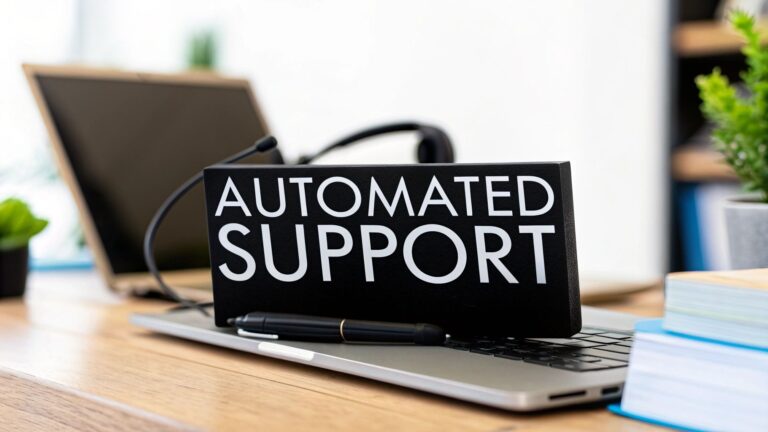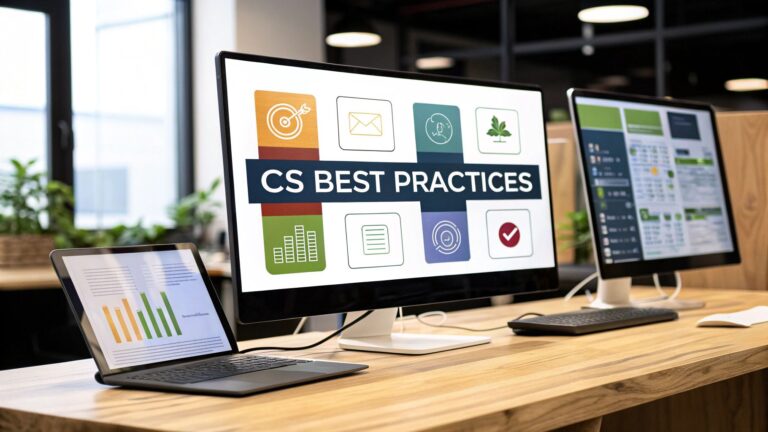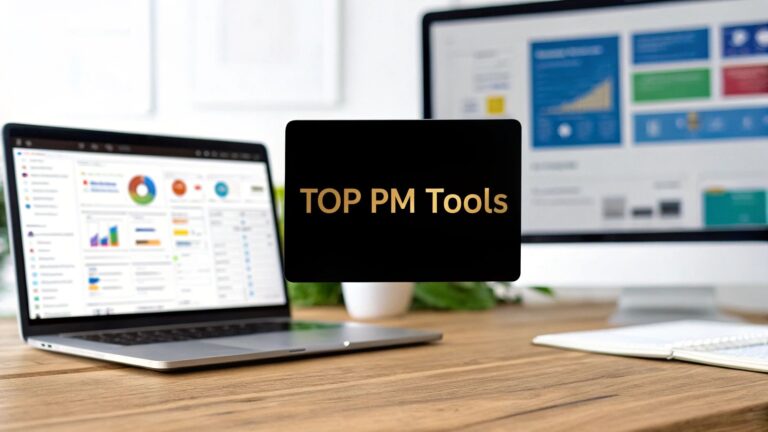Top Employee Onboarding Best Practices to Boost Engagement
In the fast-paced world of B2B and SaaS, the race to acquire top talent is fierce, but the real challenge begins after the offer letter is signed. A disorganized or lackluster onboarding process can quickly lead to disengagement, slow ramp-up times, and costly early turnover. The direct and indirect costs of replacing an employee, from lost productivity to recruitment fees, can be staggering. An effective onboarding experience isn't just a week of orientation; it's a strategic system that transforms new hires into confident, productive, and loyal team members.
Ignoring this crucial phase means you're not just risking losing a new hire; you're actively undermining your investment in them. When employees feel unsupported or unclear about their roles from the start, their potential contributions are significantly delayed. This inefficiency ripples across teams, impacting project timelines and overall morale. To mitigate the high costs of ineffective onboarding, consider adopting comprehensive strategies outlined in the latest 9 Employee Onboarding Best Practices for 2025.
This guide breaks down the nine essential employee onboarding best practices that are non-negotiable for scaling your team effectively. We'll move beyond the basics, offering actionable frameworks, practical examples, and automation tips to build a world-class program that drives retention and accelerates performance from day one. Let's explore the proven strategies that will turn your new hires into your biggest assets and ensure your initial investment pays dividends for years to come.
1. Master the First Impression: The Structured Pre-boarding Process
Effective employee onboarding best practices begin the moment a candidate accepts your offer, not on their first day. A structured pre-boarding process is your first and best opportunity to validate their decision and set the stage for long-term success. By systematically engaging new hires before their official start date, you transform first-day jitters into genuine excitement and a sense of belonging.
This proactive approach involves providing essential information, handling administrative tasks digitally, and making them feel like part of the team before they even walk through the door. It demonstrates a high level of organization and care, significantly reducing the risk of first-day no-shows and fostering a positive connection from the outset. For SaaS companies, this is the perfect time to introduce the tools they'll be using, like sending early access to internal communication platforms such as Slack or Teams.
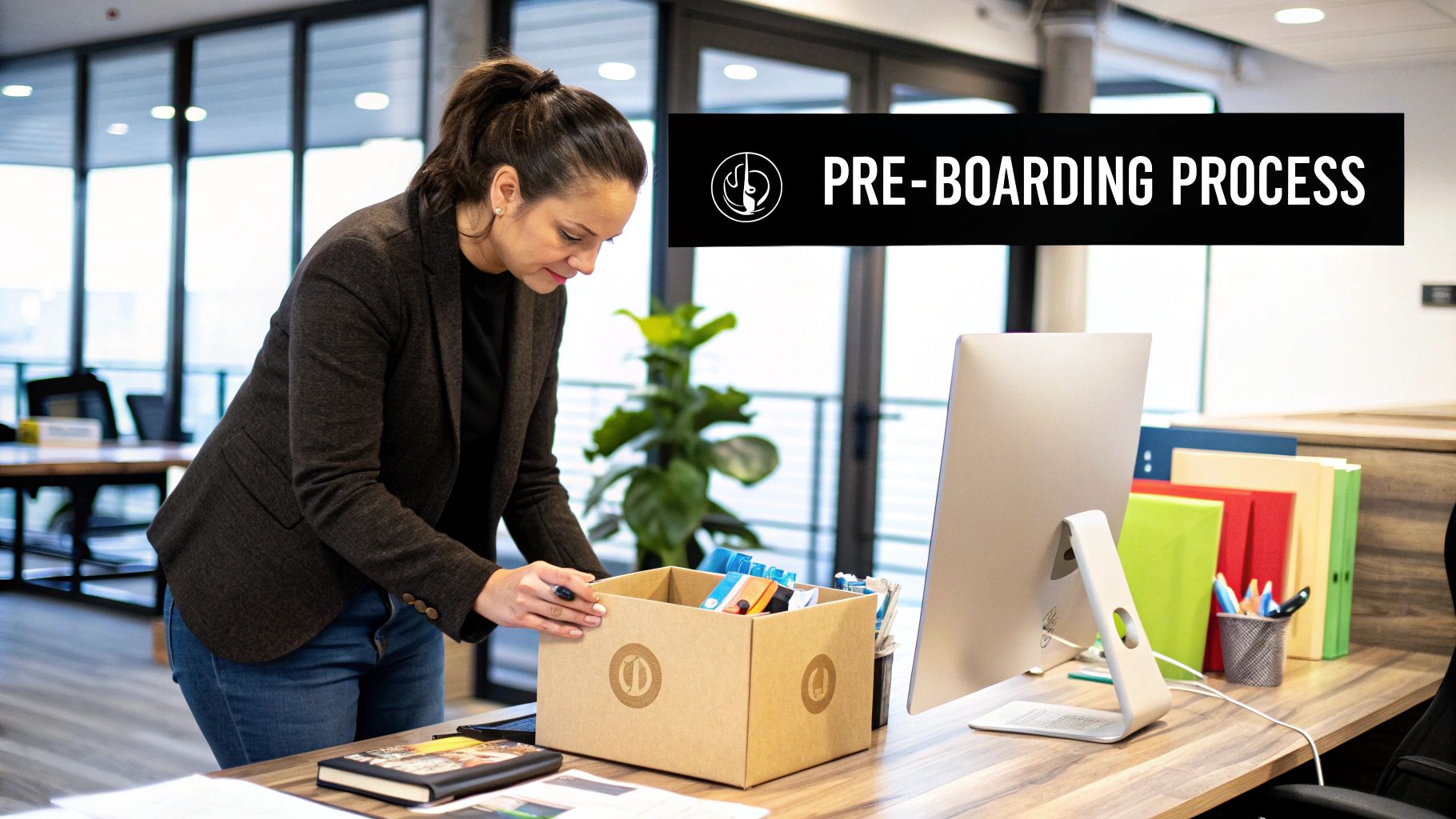
Why Pre-boarding is Non-Negotiable
The period between offer acceptance and the first day is a critical, often-overlooked phase. A lack of communication can lead to "buyer's remorse," where a new hire questions their decision or continues to entertain other offers. A well-designed pre-boarding experience bridges this gap, reinforcing their choice and building momentum. This process is strikingly similar to how companies manage new customers, a concept detailed in many guides on client onboarding best practices on makeautomation.co.
Actionable Pre-boarding Strategies
To implement this, create a clear timeline and checklist.
- 1-2 Weeks Before Start Date: Send a comprehensive welcome package. This can be digital, physical, or a hybrid. Include company swag (like a t-shirt or mug), a welcome letter from the CEO, and a high-level overview of their first week's schedule.
- Handle Paperwork Digitally: Use an HRIS or e-signature platform to complete all necessary tax forms, I-9s, and direct deposit information. This removes administrative friction on day one, allowing the focus to remain on integration and training.
- Assign a "Buddy": Introduce the new hire to their assigned onboarding buddy or mentor via email. This peer-level contact provides a friendly face and a go-to resource for informal questions they might hesitate to ask a manager.
- Prepare Their Toolkit: Ensure their laptop, software access, and any other necessary equipment are configured and ready to go. Send login credentials a day or two before they start to avoid technical delays.
2. 90-Day Structured Onboarding Timeline
The first week is crucial, but true integration doesn't happen overnight. One of the most effective employee onboarding best practices is to extend the process into a comprehensive, 90-day structured program. This timeline recognizes that becoming a fully productive and culturally aligned team member is a journey, not a sprint. It systematically guides new hires from initial orientation to full autonomy through distinct, well-defined phases.
By breaking the onboarding experience into 30, 60, and 90-day segments, companies can set clear expectations, monitor progress, and provide targeted support. This strategic approach ensures new employees feel supported long after their first week, dramatically increasing retention, engagement, and time-to-productivity. For B2B and SaaS companies, this means structuring training on complex products and sales cycles over a realistic timeframe, preventing information overload.
This timeline visualizes a typical 90-day structured onboarding program, broken into three distinct phases.
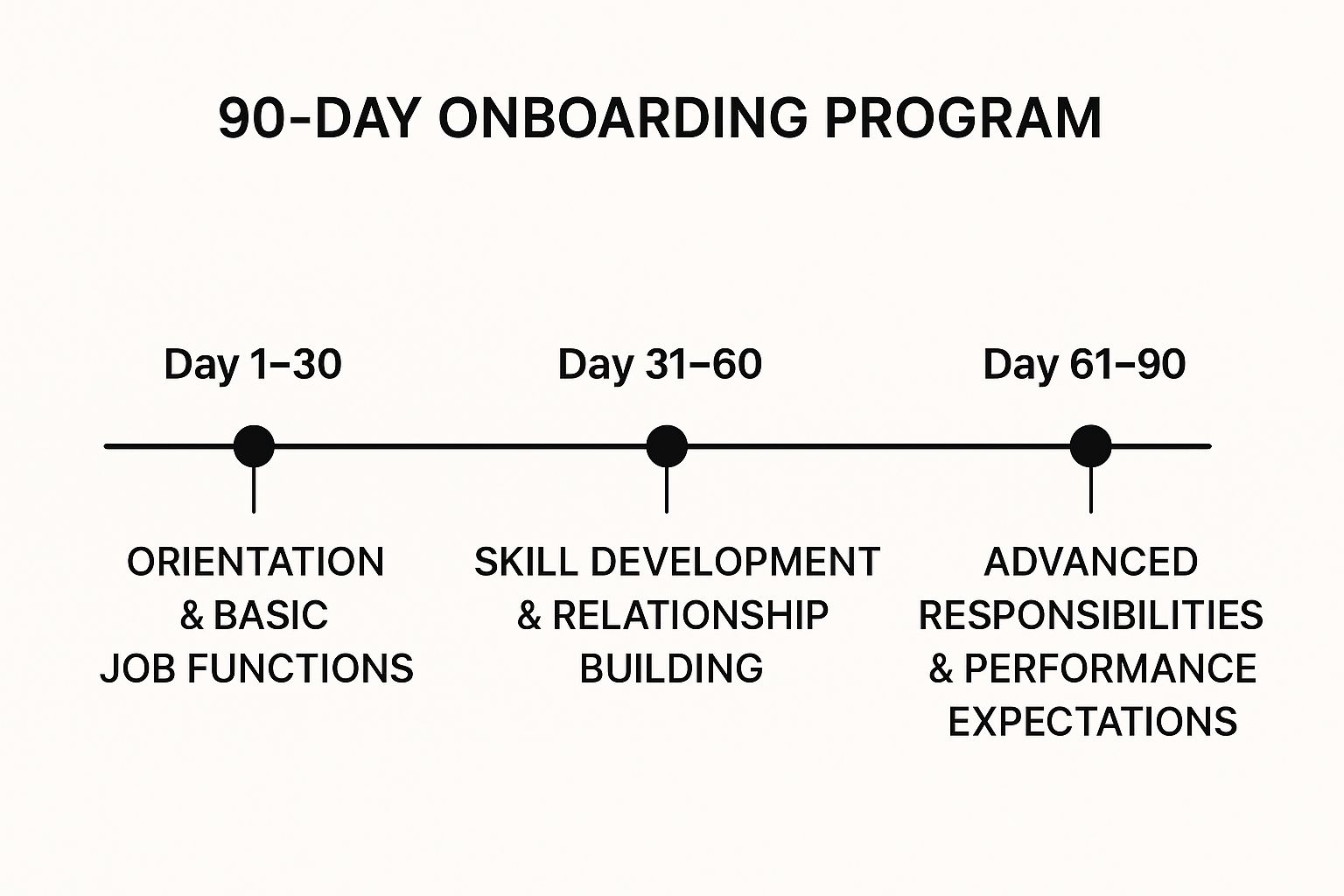
The infographic illustrates a clear progression from foundational learning to independent contribution, providing a roadmap for both the new hire and their manager.
Why a 90-Day Timeline is Crucial
A one-week orientation can leave employees feeling lost once the initial excitement fades. A 90-day plan provides a sustained support system, ensuring they build the skills, relationships, and confidence needed for long-term success. It creates a framework for continuous feedback and goal-setting, aligning the employee's development with team and company objectives. Companies like HubSpot utilize this model to map out specific learning goals for each 30-day period, ensuring a consistent and thorough integration.
Actionable 90-Day Plan Strategies
To build a successful program, define milestones and objectives for each phase.
- Days 1-30: Foundation & Integration: Focus on orientation, cultural immersion, and mastering core job functions. The goal is for the employee to understand their role, the team structure, and company values. Schedule daily check-ins for the first week, tapering to weekly one-on-ones.
- Days 31-60: Collaboration & Skill Development: Shift focus to inter-departmental collaboration, advanced training, and taking ownership of smaller projects. The new hire should be building key relationships and contributing more actively. Conduct a formal 60-day review to discuss progress and adjust goals.
- Days 61-90: Autonomy & Performance: The employee should be operating with increasing independence and taking on more significant responsibilities. This phase is about solidifying their role and demonstrating their value. A 90-day review should finalize the onboarding process and set performance goals for the future.
- Gather Continuous Feedback: Use surveys at the end of each 30-day phase to ask the new hire about their experience. This feedback is invaluable for refining and improving your onboarding program.
3. Implement a Formal Buddy/Mentor Assignment System
Beyond automated workflows and official check-ins, one of the most impactful employee onboarding best practices is creating a human connection. A formal buddy or mentor system pairs a new employee with an experienced, high-performing team member who acts as their guide, cultural ambassador, and informal support resource. This practice provides a safe space for new hires to ask practical, day-to-day questions they might be hesitant to ask their direct manager.
This system accelerates a new hire's integration by giving them a dedicated peer to navigate unwritten social rules, company-specific jargon, and internal processes. It’s not about job training; it’s about fostering a sense of belonging and psychological safety from day one. Companies like Google and Microsoft have reported that new hires with a buddy are significantly more productive and satisfied in their first 90 days.

Why a Buddy System is a Game-Changer
A new role can be isolating. The buddy system directly combats this by creating an immediate personal connection, which is proven to boost engagement and retention. While managers focus on performance and goals, a buddy provides context and camaraderie. This relationship helps new employees build their internal network faster, understand the company culture on a deeper level, and feel like a valued part of the team, not just another new face.
Actionable Buddy Program Strategies
To launch an effective buddy program, structure is key.
- Select Buddies Carefully: Choose experienced employees who not only excel at their job but also embody your company's core values and possess strong communication skills. Their role is to be a positive influence and a reliable resource.
- Provide Clear Guidelines: Equip buddies with a checklist of topics to cover, such as introducing the new hire to key team members, explaining communication norms (e.g., when to use Slack vs. email), and scheduling a few informal check-ins or coffee chats during the first few weeks.
- Define the Relationship's Scope: Set clear expectations for the duration of the formal buddy relationship, typically the first 30 to 90 days. This ensures the commitment is manageable for the buddy and provides a clear timeline for the new hire's initial integration phase.
- Recognize and Reward Mentors: Acknowledge the extra effort your buddies put in. Public recognition, small bonuses, or making mentorship a consideration in performance reviews can incentivize participation and highlight the program's importance.
4. Interactive Cultural Immersion
True cultural alignment isn't achieved by handing a new hire a values pamphlet; it’s built through shared experience. Interactive cultural immersion moves beyond passive presentations, actively engaging new employees in activities that demonstrate and reinforce your company’s core identity. This hands-on approach helps new hires internalize organizational values, norms, and ways of working by experiencing them firsthand.
Instead of just telling them about your collaborative culture, you place them in a team-based problem-solving workshop. This method makes abstract concepts tangible, accelerating the process of feeling like a genuine part of the organization. It's a critical component of modern employee onboarding best practices because it transforms culture from a talking point into a lived reality, ensuring values are understood and adopted from day one.
Why Immersion Beats Information
Simply listing company values on a slide deck is forgettable. New hires need to see those values in action and understand how they translate to daily decisions and behaviors. When employees actively participate in cultural activities, they form stronger emotional connections and a deeper, more nuanced understanding of "how things are done around here." This is what separates companies with a strong, unified culture from those where values are just words on a wall.
This approach was famously pioneered by companies like Zappos, whose immersive culture camp ensures every new hire, regardless of role, deeply understands their commitment to customer service. Southwest Airlines also excels here, using fun, interactive sessions to demonstrate their legendary culture of humor and heart.
Actionable Cultural Immersion Strategies
To build your own immersive experience, focus on participation over presentation.
- Host a "Values in Action" Workshop: Create scenarios based on real work situations where new hires must collaborate to make a decision that reflects company values. For example, a SaaS company focused on customer-centricity could run a workshop where teams troubleshoot a complex, fictional customer issue.
- Facilitate Founder or Leadership Storytelling: Organize a session where a founder or a tenured leader shares stories about key moments in the company’s history. Hearing about the challenges, failures, and pivotal decisions that shaped the culture makes it more memorable and human.
- Organize Cross-Functional Shadowing: Have new hires spend a few hours with different departments. This not only builds empathy and understanding across the organization but also shows them how the company culture manifests in various teams and functions.
- Create a Culture-Focused Scavenger Hunt: Design a fun, interactive game where new hires must talk to different employees to find answers to questions about company traditions, inside jokes, or historical milestones. This encourages organic interaction and relationship-building.
5. Role-Specific Training and Skill Development
Moving beyond a generic company overview, one of the most critical employee onboarding best practices is implementing customized training that directly addresses the competencies, tools, and knowledge required for a new hire's specific role. This targeted approach accelerates their time-to-productivity by focusing on practical skills they will use daily, rather than overwhelming them with irrelevant information. It demonstrates a clear investment in their professional growth and equips them to contribute meaningfully from the start.
This method transforms onboarding from a passive orientation into an active, hands-on learning experience. For a SaaS sales representative, this might mean intensive CRM training and mock-call sessions. For a software developer, it could involve deep dives into the existing codebase and development environment. This specificity ensures that new employees are not just culturally integrated but are also fully equipped to excel in their unique functions, boosting both confidence and performance.
Why Generic Training Falls Short
A one-size-fits-all onboarding program can leave new hires feeling unprepared for the realities of their job. It often fails to cover the specific software, processes, and performance expectations that are unique to their team and responsibilities. Role-specific training bridges this gap, providing the contextual knowledge needed to navigate their duties effectively and make an immediate impact. This approach is essential for reducing the learning curve and enabling new team members to meet their goals faster.
Actionable Role-Specific Training Strategies
To build an effective role-based program, start by deconstructing the job itself.
- Conduct a Job Analysis: Work with department heads and top performers to identify the core competencies, skills, and knowledge critical for success in each role. This analysis forms the foundation of your training curriculum.
- Develop Blended Learning Paths: Combine different training methods for maximum engagement. Use e-learning modules for foundational knowledge, hands-on simulations for practical application (like using your SaaS product), and peer-led sessions for process walkthroughs.
- Create Clear Competency Milestones: Define what a new hire should be able to do at the 30, 60, and 90-day marks. Use these milestones to structure the training and provide clear benchmarks for progress assessment.
- Involve Subject Matter Experts (SMEs): Leverage the expertise of veteran employees to create and deliver training content. Their real-world insights are invaluable, and this process is a key part of how to create training manuals on makeautomation.co that are both accurate and practical.
6. Technology Integration and Digital Tools
Modern employee onboarding best practices are deeply rooted in the strategic use of technology. Integrating digital tools and platforms transforms a manual, often inconsistent process into a streamlined, engaging, and scalable experience. This approach automates administrative tasks, delivers consistent training, and provides new hires with on-demand access to critical information, freeing up HR and managers to focus on high-impact, human-centric activities.
By leveraging technology, you create a cohesive digital ecosystem that supports the new hire from pre-boarding through their full integration. For SaaS and B2B tech companies, this is a natural extension of their own product philosophy, demonstrating operational excellence and a commitment to efficiency. Companies like IBM showcase this by using AI-powered chatbots to answer new hire questions and personalized digital learning paths to guide their development.
Why Digital Integration is Essential
In a remote or hybrid work environment, technology isn't just a convenience; it's the foundation of the entire onboarding experience. A well-integrated tech stack ensures that every employee, regardless of location, receives the same high-quality information and support. This consistency is crucial for building a unified company culture and ensuring compliance. It also provides valuable data and analytics on program effectiveness, allowing for continuous improvement.
Actionable Technology Strategies
To effectively integrate technology, focus on creating a seamless user journey.
- Centralize with an Onboarding Platform: Use a dedicated onboarding software or configure your HRIS to act as a central hub. This single source of truth should house all documents, training modules, and schedules, reducing confusion and information overload for the new hire.
- Automate Workflows: Leverage tools like Slack or Microsoft Teams to create automated onboarding workflows. Set up scheduled messages that introduce team members, share key resources, or assign introductory tasks, guiding the new hire through their first days and weeks.
- Embrace Immersive Training: For complex roles or products, consider innovative tools. Walmart famously uses VR technology to simulate real-world store environments for training, a powerful example of how immersive tech can accelerate learning and improve retention.
- Prioritize a Human-Digital Balance: While automation is powerful, ensure technology facilitates rather than replaces human connection. Use digital tools to schedule one-on-one check-ins, coffee chats with teammates, and feedback sessions with managers.
7. Manager Training and Involvement
An employee's direct manager is the single most influential person in their onboarding experience, yet many organizations leave them unprepared. A systematic approach to training and involving managers transforms them from passive observers into active onboarding champions. This practice equips supervisors with the tools, expectations, and skills needed to effectively integrate new talent, directly linking their efforts to employee retention and performance.
This approach recognizes that even the best HR-led program can fail if the manager isn't an engaged partner. By providing structured guides and clear responsibilities, you empower managers to build strong relationships, set clear expectations, and accelerate a new hire's path to productivity. For SaaS companies, a manager's ability to contextualize the new hire's role within the broader product and customer ecosystem is invaluable, making their involvement a critical component of effective employee onboarding best practices.
Why Manager Involvement is Non-Negotiable
A disengaged or unprepared manager creates a bottleneck that undermines the entire onboarding process. New hires look to their direct supervisor for guidance, context, and support. When managers are not equipped to provide this, it leads to confusion, isolation, and a slower ramp-up time. Investing in manager training ensures consistency and quality, reinforcing the company's commitment to employee success.
This proactive training directly contributes to long-term team cohesion and output, a key component of building a high-performing workplace. Strong manager involvement is a cornerstone of what defines organizational effectiveness on makeautomation.co, as it ensures that new hires are quickly and successfully integrated into the team's workflow and culture.
Actionable Manager Training Strategies
To implement this, build a dedicated toolkit for your people leaders.
- Provide Structured Conversation Guides: Equip managers with a checklist and talking points for 30-60-90 day check-ins. This ensures critical conversations about performance, role clarity, and professional development happen consistently. LinkedIn successfully uses this model to standardize manager-led onboarding conversations.
- Set Clear Expectations and Time Commitment: Create a "Manager's Onboarding Playbook" that outlines their specific responsibilities, from preparing the workspace to scheduling introductory meetings and defining initial projects.
- Offer Just-in-Time Coaching: Provide managers with resources and support throughout the onboarding period. This could be a dedicated Slack channel for managers of new hires or brief coaching sessions with HR business partners.
- Measure and Recognize Excellence: Track metrics related to manager involvement, such as the completion of 30-day check-ins or new hire feedback on their manager's support. Publicly recognize and reward managers who excel at onboarding to reinforce its importance.
8. Early Wins and Quick Value Creation
One of the most powerful employee onboarding best practices is to structure the first few weeks around achieving early, tangible wins. This strategic approach involves assigning new hires meaningful, yet manageable, projects that allow them to contribute real value almost immediately. This method moves beyond passive learning and empowers employees to actively participate, building confidence and accelerating their integration into the team's workflow from day one.
By creating opportunities for quick success, you demonstrate trust in their abilities and show them how their work directly impacts the company's goals. This practice is especially effective in fast-paced SaaS and tech environments where rapid contribution is highly valued. It transforms the initial onboarding period from a time of observation to a period of active, impactful engagement.

Why Early Wins Matter
The primary goal is to combat the feeling of being overwhelmed or unproductive that often plagues new hires. When an employee sees their contribution making a difference within their first week, it validates their decision to join the company and boosts their motivation. Companies like GitHub excel at this by having new developers fix a small, low-risk bug on their first day, giving them an immediate sense of accomplishment and familiarity with the codebase.
Actionable Strategies for Quick Value
To implement this, managers should identify suitable "starter" projects before the new hire's first day.
- Choose Low-Risk, High-Impact Tasks: Identify projects that are meaningful but have a manageable scope and minimal risk if mistakes are made. This could be a small feature update, a piece of content, or optimizing an internal process.
- Provide a Clear Support System: Ensure the new hire has all the resources, documentation, and a designated mentor or buddy to guide them. The goal is to set them up for success, not to test them.
- Celebrate the Achievement: Publicly recognize the new employee's first contribution in a team meeting or a company-wide chat. This positive reinforcement validates their work and makes them feel like a valued member of the team.
- Build Momentum: Use the confidence gained from the first win to gradually introduce more complex and challenging responsibilities. This creates a natural progression of growth and learning.
9. Continuous Feedback and Improvement
Effective employee onboarding is not a "set it and forget it" program; it is a dynamic, living process that must evolve. The best onboarding programs treat the experience as a product that requires continuous iteration based on user feedback. By establishing a systematic approach to gathering, analyzing, and acting on input from new hires, you ensure your process remains relevant, effective, and aligned with both employee needs and business goals.
This practice transforms onboarding from a static checklist into a strategic, data-driven function. It demonstrates a commitment to employee experience and shows new hires that their voice matters from day one. For SaaS companies that live by agile principles and user feedback loops in product development, applying this same mindset to HR processes is a natural and powerful extension. Companies like Google use detailed analytics and A/B testing to optimize their onboarding, treating it with the same rigor as a product launch.
Why a Feedback Loop is Essential
Without a formal feedback mechanism, onboarding processes can quickly become outdated, ineffective, or misaligned with what new hires actually need to succeed. Assumptions about what is working can lead to blind spots, resulting in disengagement and lower retention. A continuous feedback loop provides the data needed to make informed improvements, turning anecdotal evidence into actionable insights and justifying investments in the program.
Actionable Feedback Strategies
To build a culture of continuous improvement, integrate feedback collection at multiple points.
- Implement Pulse Surveys: Use short, automated surveys at key milestones (end of week 1, 30 days, 60 days, 90 days) to capture real-time sentiment. Ask targeted questions about their training, manager support, and sense of belonging.
- Conduct Onboarding Retrospectives: Inspired by agile methodologies, hold group sessions with cohorts of new hires after their initial 90 days, similar to how Spotify runs its retrospectives. Discuss what went well, what was confusing, and what could be improved for the next group.
- Gather Manager Feedback: New hires are only half the equation. Regularly survey managers to understand their perspective on new employee readiness, the clarity of the process, and the support they received in their role as an onboarder.
- Track Key Onboarding Metrics: Go beyond satisfaction scores. Monitor quantitative data like time-to-productivity, 90-day retention rates, and completion rates of training modules to measure the tangible impact of your program and identify areas for optimization.
Employee Onboarding Best Practices Comparison
| Onboarding Approach | Implementation Complexity | Resource Requirements | Expected Outcomes | Ideal Use Cases | Key Advantages |
|---|---|---|---|---|---|
| Structured Pre-boarding Process | High upfront planning and tech setup | Coordination, digital tools | Reduced first-day stress, increased early engagement | New hires needing early preparation | Streamlines admin, demonstrates readiness |
| 90-Day Structured Onboarding Timeline | Sustained commitment over 3 months | Manager and HR time, structured content | Higher retention, clear milestones | Roles requiring phased skill development | Systematic skill building, clear expectations |
| Buddy/Mentor Assignment System | Moderate; depends on mentor training | Time investment from mentors | Accelerated cultural integration, support | Teams valuing peer support | Builds relationships, reduces manager load |
| Interactive Cultural Immersion | High; requires design of engaging activities | Significant time and resources | Deep cultural understanding and engagement | Companies emphasizing strong culture | Emotional connection, authentic relationships |
| Role-Specific Training and Skill Development | High; custom content creation | Content experts, training modules | Faster productivity, job competence | Specialized roles needing targeted skills | Measurable learning outcomes, reduces errors |
| Technology Integration and Digital Tools | High initial tech investment | Hardware, software, support | Consistent info delivery, scalable onboarding | Distributed or remote teams | Efficiency, accessibility, data tracking |
| Manager Training and Involvement | Moderate to high; ongoing development required | Manager coaching and tools | Greater new hire retention and engagement | Organizations emphasizing leadership role | Stronger manager-employee bonds, shared responsibility |
| Early Wins and Quick Value Creation | Moderate; project planning needed | Manager time for support | Increased confidence and early contributions | Fast-paced environments wanting quick impact | Builds motivation, provides immediate value |
| Continuous Feedback and Improvement | Moderate to high; requires ongoing analysis | Tools for data collection and analysis | Adapted, effective onboarding over time | Organizations focused on continuous improvement | Data-driven enhancements, proactive problem-solving |
From Onboarding to Advantage: Automating Your Path to Retention
We've explored an extensive list of employee onboarding best practices, moving from the foundational importance of a structured pre-boarding process to the long-term value of continuous feedback. Each element, from assigning a dedicated buddy and crafting a 90-day plan to ensuring managers are actively involved and celebrating early wins, is a critical piece of a much larger puzzle. Individually, they are effective tactics. Collectively, they form a powerful strategic system that transforms a new hire's initial days into a launchpad for long-term success, engagement, and retention.
The core takeaway is this: exceptional onboarding isn't a one-time event or a simple checklist. It's an ongoing, dynamic process that signals to your new team members that you are invested in their growth from day one. It’s your first, and arguably most important, opportunity to embed your company culture, clarify expectations, and equip employees with the tools, knowledge, and relationships they need to thrive. Neglecting this crucial phase is like building a powerful engine but forgetting to add oil. It might run for a little while, but performance will inevitably suffer, and a breakdown becomes unavoidable.
From Process to Strategic Advantage
Mastering these onboarding principles moves your organization beyond basic HR compliance and into the realm of strategic talent development. A well-executed program directly impacts key business metrics: it shortens the time-to-productivity, reduces costly early-stage turnover, and fosters a more cohesive, collaborative work environment. When employees feel supported and see a clear path for themselves within the company, they are more likely to become dedicated brand advocates and high-performing contributors.
To ensure your onboarding efforts translate into long-term organizational success and retention, it's crucial to integrate them into a robust modern talent management strategy. Onboarding is the gateway to the entire employee lifecycle, setting the stage for future performance management, skill development, and career pathing.
Your Actionable Next Steps: Audit, Automate, and Iterate
Turning this knowledge into action is the next critical step. Don't feel pressured to implement all nine practices overnight. Instead, use this guide as a framework for improvement.
-
Conduct an Honest Audit: Where does your current onboarding process excel, and where does it fall short? Use the practices we've discussed as a benchmark. Survey recent hires for candid feedback to identify the most significant pain points and opportunities for immediate improvement.
-
Prioritize High-Impact Changes: Identify the "quick wins." Perhaps implementing a buddy system or creating standardized 90-day role templates is the most achievable first step. Focusing on one or two key areas will build momentum for broader changes.
-
Embrace Strategic Automation: The true key to scaling a world-class onboarding experience is automation. Manual tracking of checklists, sending reminder emails, and scheduling training sessions is not sustainable for a growing B2B or SaaS company. Implementing automated workflows ensures consistency, frees up your HR and management teams for more high-touch, human interactions, and guarantees that no new hire falls through the cracks.
Ultimately, investing in a sophisticated onboarding program is an investment in your company's future. It's a declaration that you value your people not just for the work they do today, but for the potential they hold for tomorrow. By systematizing these employee onboarding best practices, you are building a resilient, scalable foundation for a culture that attracts, develops, and retains top-tier talent.
Ready to transform your onboarding from a manual chore into an automated, scalable engine for growth? The experts at MakeAutomation specialize in designing and implementing custom workflows that ensure every new hire receives a consistent, world-class experience. Visit MakeAutomation to learn how we can help you build the onboarding machine your business deserves.




